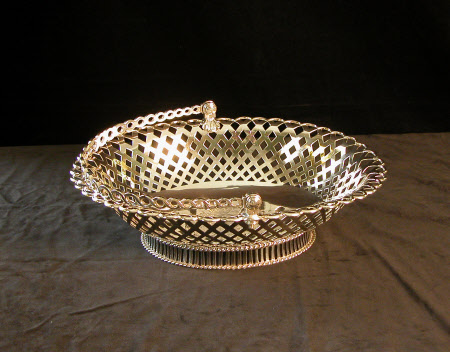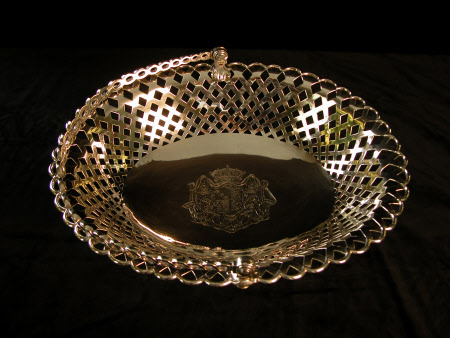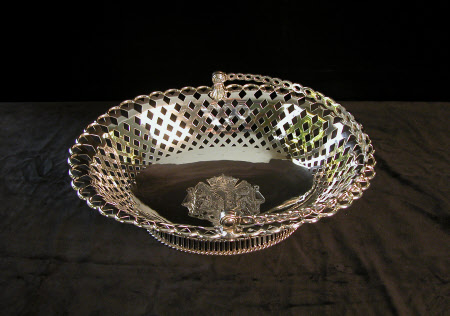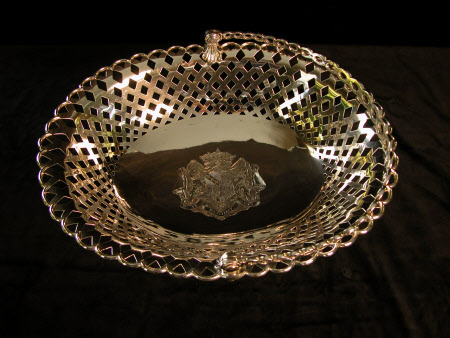Pair of bread baskets
John Robinson II (fl. 1738-73, London)
Category
Silver
Date
1754 - 1755
Materials
Sterling silver
Measurements
29.2 x 37.5 x 29.5 cm
Place of origin
London
Order this imageCollection
Ickworth, Suffolk
NT 852109
Summary
Pair of bread baskets, sterling silver, by John Robinson II, London, 1754/5. The splayed oval baskets with concave bases are raised and diaper-pierced with a flaring rim terminating in a scalloped edge with an applied moulded wire. The pierced and seamed gallery rim feet are bounded top and bottom by corded wires and the curved open guilloche handles are cast, terminating in button hinges with cast leaf attachments soldered to the inside face of the top of the basket. Heraldry: In the centre of each basket is engraved the quartered shield, supporters and motto of the 2nd Earl of Bristol within an ermine mantling and beneath an earl’s coronet. Hallmarks: Both are fully marked on their undersides with maker’s mark ‘JR’ in italics beneath an eight-pointed star (Arthur Grimwade, London Goldsmiths 1697-1837, 1990, no. 1630), date letter ‘t’, lion passant and leopard’s head. The handles have the maker’s mark and lion passant only. Scratchweights: ‘N. 1 [/] 42″16’ and ‘No. 2 [/] 42″0’.
Full description
This model, which evolved from the flat-bottomed and more naturalistic baskets of earlier in the century (see NT 852063), was at the height of its popularity in the 1750s. With minor variations it was produced by a number of different goldsmiths including Benjamin Cartwright, Edward Aldridge, Samuel Herbert and Co. and John Robinson.[1] The relative plainness of the baskets and the fact that they do not match those by de Lamerie and Kandler (NT 852063.1 & 2) may indicate that they were intended for Lord Bristol’s ‘every day’ service of silver.[2] Once the other baskets had been augmented and gilded for dessert in 1768, however, these would have been the only ones available to the 2nd Earl and his successors. Their simplicity of form and lightness in appearance would have suited the burgeoning neoclassicism of the late eighteenth century and rendered them fitter for the grandest of dinner tables. James Rothwell, Decorative Arts Curator April 2021 [Adapted from James Rothwell, Silver for Entertaining: The Ickworth Collection, London 2017, cat. 50, p. 134.] Notes: [1] Christie’s 13 June 2000, lot 204 (Benjamin Cartwright, 1751); Sotheby’s 15 June 1978, lot 41 (Edward Aldridge, 1751); Sotheby’s 19 July 1982, lot 124 (Samuel Herbert & Co., 1753). [2] Sir Benjamin Keene, Lord Bristol’s predecessor as ambassador at Madrid, made a distinction between his wrought plate for dining in state and that of plain form ‘for every day’s use.’ Sir Richard Lodge (ed.), The Private Correspondence of Sir Benjamin Keene, Cambridge 1935, p. 240.
Provenance
George Hervey, 2nd Earl of Bristol (1721-75); by descent to the 4th Marquess of Bristol (1863-1951); accepted by the Treasury in lieu of death duties in 1956 and transferred to the National Trust.
Credit line
Ickworth, the Bristol Collection (National Trust)
Makers and roles
John Robinson II (fl. 1738-73, London), goldsmith



